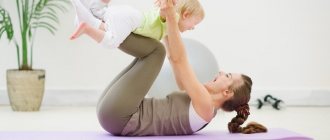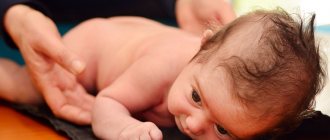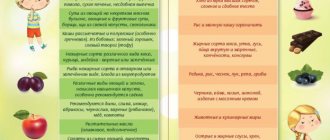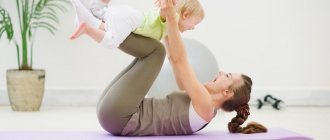It is important!
The benefits of gymnastics are undeniable, but before you start exercising with your baby, you should definitely consult with your pediatrician. During the first weeks after the hospital, he will visit you at home. There are few contraindications against gymnastics for a baby, but they still exist. You should refrain from exercise if the child has skin diseases, problems with the heart and respiratory system, and others. In some cases, a child requires a professional massage, which cannot be replaced by independent gymnastics at home.
About the benefits of gymnastics
Along with massage, a 3-month-old child needs a special set of gymnastic exercises. Due to his age, he cannot do them himself, so he needs his mother’s help. The benefits of such activities are unconditional:
- They help eliminate or prevent hypotonicity and hypertonicity.
- Develops the baby's arms and legs.
- They give him the opportunity to learn to control his own body and improve coordination.
- Regular moderate physical activity has a beneficial effect on the development of hearing and speech. This happens due to the fact that the mother almost always comments on her actions out loud.
- Exercising is a great way to help your child relax.
- Regular exercise helps strengthen the cardiovascular system and is good for breathing and circulation.
The child with whom they exercise will learn to crawl much earlier, and then walk, and will feel more confident in doing so. That’s why mom needs to pay special attention to the baby’s physical activity and exercise regularly with him, especially since such a pastime will give both of them a lot of pleasant moments.
What time to do gymnastics
Gymnastics should be done daily, 3-5 1-2 sessions per day. Perform exercises at least half an hour before meals or 1 hour after feeding.
Conditions for classes
- Ventilate the room where you will study with your baby. The room should be warm, but not hot. The optimal temperature is 20-21 degrees. During the massage, the child also takes air baths - an important hardening factor.
- Conduct classes on a flat, hard surface: on a changing or regular table, or the lid of a chest of drawers. A bed or sofa is not suitable for these purposes, as it will sag under the child and there will be no effect from the exercises. To make your baby comfortable, place a thin blanket on the tabletop and cover it with a diaper.
- The child should be in a good mood, calm and active. If he wants to sleep, is capricious or unwell, classes should be postponed.
- The mother should also tune in to communicate with the baby, not rush anywhere, and not fuss.
- Gymnastics should be combined with air baths. Undress your baby and remove his diaper. Let nothing hinder his movements.
- While doing the exercises, talk to your baby, recite nursery rhymes, and sing songs. You can turn on soft background music.
Tummy massage as a way to relieve colic
During feeding, the newborn swallows air, as a result of which colic cannot be avoided, which causes severe discomfort to the baby. With the right movements and pressure, you can help gas bubbles burst in the intestines or help them escape. In this case, you need to understand how the intestines work, namely the large intestine.
An important rule is that any type of anti-colic massage is performed clockwise. It is also highly recommended not to massage immediately after eating; you need to wait 1-1.5 hours. Massage is prohibited during the acute phase of colic; this will cause the baby even more pain. First you need to warm the baby's tummy with a warm diaper. No need to use oils or cream.
Exercises for babies up to 2 months
- Place your baby on his back. With both hands, make light stroking movements from the center of the chest to the sides - 3-5 times.
- Stroke the baby's tummy in a clockwise circular motion - without effort, without pressing.
- Let your baby wrap his fist around your finger. Stroke his arms one by one, moving from the hands to the shoulders – 5-6 times. Then gently massage your brushes.
- Stroke your baby's legs 5-6 times from the feet to the hips. Then with your thumb, gently press on the baby’s foot at the base of the toes - the baby will reflexively press them. Maintaining light pressure, move along the foot to the heel. Repeat 5 times for each leg.
- Turn the baby onto his stomach. Stroke his back from head to buttocks with the back of your hand 6-7 times.
- Place your palms on your baby's feet and apply gentle pressure as if pushing them forward. The baby will make reflexive attempts to crawl. The exercise helps strengthen the muscles of the back and abdomen, and trains the legs.
- Turn the child onto his side. Without pressing, move your finger along the spine from top to bottom. The baby will reflexively arch his back and return to his original position. Do the exercise 1-2 times on each side.
Unusual exercise at 3 months
So, in this section you will be presented with a step-by-step description of seventeen simple exercises. These exercises with massage elements are perfect for exercising with a three-month-old baby.
Exercise 1.
Let's start with the handles. Take the brush and gently rub the skin in a circular motion. Move to the elbow from the hand, and from the elbow to the shoulder. Make 4-6 turns. The strokes should be light, but the skin on the handle should turn red by the end of the massage. This means that blood circulation has become more intense.
Exercise 2.
The baby lies on his back. Cross his arms over your chest, while making sure he is holding onto your fingers. Then begin to move the handles to the sides and return to the starting position. You can do this with shaking movements. Repeat several times.
Exercise 3.
Now lift the baby's arms up and gently lower them down. Alternately along the body, and then spreading to the sides.
Exercise 4.
Make several circular movements with your hands clockwise and counterclockwise. The arm should rotate at the shoulder joint. If this is your first time doing this exercise, avoid sudden movements so as not to injure your child. If this is not your first time doing this, the movements may be more intense.
Exercise 5.
If the child does not yet know how to roll over on his tummy, encourage him. Holding one arm and legs, move your body forward. He will move his head and shoulders and turn onto his stomach. Then return it to its original position. Make several turns, alternating between the right and left sides. The number of turns should be small at first, up to 3. Then they can become more.
Exercise 6.
The child lies on his back. Gently grab it by the handles and make a movement that imitates the movement of a swimmer underwater.
Exercise 7.
Massage your baby's palms and fingers. Gently bend and straighten his hands. Move your index finger clockwise and counterclockwise across your palm. Bend and straighten his fingers. You can use some funny nursery rhyme or finger game. The white-sided magpie is perfect for this.
Exercise 8.
Massage your baby's tummy. Limit yourself to gentle stroking, do not press hard. Do not tap under any circumstances, otherwise you may cause harm. Please note that you cannot massage the tummy or rub it if the baby has just eaten. And before doing this, make sure that nothing hurts him.
Exercise 9.
Turn the baby onto his tummy and gently massage his back. Make strokes with both hands, rising from the buttocks to the shoulders and descending back. Repeat 4-5 times.
Exercise 10.
From stroking, move on to rubbing. They are much more intense and involve moving your baby’s skin with your hands. They increase blood circulation. Ideally, they should not cause any unpleasant sensations in the baby, but if he doesn’t like it, don’t insist. Make movements straight and in a spiral.
Exercise 11.
Turn the baby from the tummy to the back and massage the chest. Do regular and circular movements, starting with the lightest ones. Use your fingertips to massage the ribs without pressing or using force.
Exercise 12.
Massage the baby's legs, making longitudinal movements with your hands. Then grab the leg with one hand and with the other make circular movements up to the knee from the foot. And then massage your thighs in the same way. Repeat the exercises several times. The skin should turn red after this.
Exercise 13.
Massage your baby's feet. Stroke and rub the skin in a circular motion from heels to toes.
Exercise 14.
Make circular movements with your legs (bicycle), straightening each of them alternately. This exercise strengthens the muscles that your child will need when he begins to walk.
Exercise 15.
Bring the baby to a conditionally standing position. His feet touch the surface on which he was previously lying. He himself will begin to rest his legs on it one by one and thus imitate walking.
Exercise 16.
This exercise is performed on a fitball. It is imperative to follow safety rules so that your child does not slip or hit himself. It strengthens the muscles and vestibular apparatus. The child lies with his tummy on the ball, legs apart. Holding it by the back, swing the ball. This is how the baby learns to navigate space and coordinate movements.
Exercise 17.
Now turn the baby onto his back and repeat the exercise. This time, hold it in the chest area to prevent it from slipping. Rock the exercise ball back and forth for a minute.
Exercises for babies 2-6 months
Gymnastics for babies over two months of age should also begin with a light massage. Under no circumstances do we press on the baby’s skin or apply any force. We add more complex exercises to the previous complex:
- After massaging your hands, let your baby hold your thumbs and spread his arms to the sides. Having fixed them in this position for a couple of seconds, cross the baby’s arms over his chest. Repeat the exercise several times, alternating hands: first the right one on top, then the left one.
- After massaging the legs, grab your baby's shins. Perform the “bicycle” exercise: bend your legs one by one, pressing them to your stomach. Then bend both legs at the same time several times.
- Grab your baby's torso under the arms and lift him vertically. Let him touch his feet—not his toes—to a flat surface. He should reflexively step with his legs, as if walking. It is important to keep the baby suspended. The baby should not fully lean on his legs. They, like the baby’s spine, are not yet ready for such loads.
More complex complexes must be discussed with your doctor. Remember, every child is unique, you need to approach classes taking into account the individual characteristics of your baby.
For parents: how to properly organize exercise therapy for infants
A gymnastics course is prescribed to an infant by a doctor; it can be completed either under the supervision of a specialist or at home, on your own. When exercising with a baby at home, parents should definitely remember the specifics of the exercises and their purpose.
Thus, a complex of exercise therapy in the presence of any congenital disease, for example, torticollis in infants, will be somewhat different from exercises performed with a healthy child who does not have any injuries.
Attention! You cannot start gymnastics with a congenital pathology on your own; all exercises are performed strictly on the recommendation of a doctor!
General instructions for classes are as follows:
- Before starting, an adult should wash their hands thoroughly, there should be no jewelry on their fingers or wrists, and their nails should be cut short to avoid scratches and injuries.
- The baby should not wear tight clothing that restricts movement. Gymnastics is performed in a light vest, T-shirt or naked. A diaper is allowed if necessary.
- While performing the exercises, you should carefully monitor the child’s mood and well-being and stop immediately if a negative reaction appears.
- Exercise therapy classes for infants are carried out for 10-15 minutes, no more. Exercises are performed on a flat, moderately hard surface, open to adult access from at least three sides.
When carrying out exercise therapy on a fitball for infants, a fresh diaper is required, the adult must be as attentive and collected as possible.
conclusions
- Gymnastics strengthens muscles, gives the baby a good appetite, healthy digestion and sound sleep.
- Classes should be carried out half an hour before meals or 1 hour after, in a ventilated room, on a flat, hard surface.
- When working with a newborn, it is enough to make light stroking movements: from the center of the chest to the sides, from the hands to the shoulders, from the feet to the hips, from the neck to the buttocks. The tummy should be stroked in a clockwise circular motion.
- As the baby gets older, you need to add reflex crawling and walking, straightening the back in a side position, and bending the arms and legs to the exercises.
- The technique of performing gymnastics for infants should be agreed upon with a doctor. If you are unsure how to do an exercise, ask a massage nurse to teach you. Unskillful movements can harm the child.
Massage
Six-month-old children, as a rule, quickly get used to gymnastics and massage if done regularly. Exercises bring pleasure, improve mood and increase emotional tone.
It would not be amiss to say that this set of activities forms correct posture in a 6-month-old child. And massage alone has a beneficial effect on the following body functions:
- improves blood circulation;
- dilates blood vessels;
- enhances the functions of the sebaceous and sweat glands;
- strengthens the musculoskeletal system;
- tones muscles.
Massage, like gymnastic procedures, should be carried out in a ventilated room. The air temperature in the room should be 20-22 degrees. It's good if quiet, calm music plays. Use a comfortable table, which should be covered with a flannelette blanket, put an oilcloth and cover with a diaper on top. Before class, you need to wash and dry your hands. The baby should be undressed gradually so that he gets used to the temperature in the room.
At the age of 6 months, gymnastics for children is essentially a simple massage plus simple movements that will be pleasant to the baby and will not cause harm. You need to start with gentle stroking of the body: neck, tummy, arms, legs. This is a warming procedure that prepares for further actions.
After stroking, you can move on to rubbing. Movements should be slow and delicate, as children's skin is very sensitive. You should also rub each part of the body separately. Handles - from the palms to the shoulder, legs - from the heels to the hips, then the stomach and sides. Rubbing, like stroking, is done along the body.
Next, you can “roll” the child by rolling from one side to the other, holding him with your palms. These movements are great for stretching your limbs.
And to complete the charging, pinching and tapping are applied. Remember that these movements should be gentle and careful, but at the same time quite vigorous. These procedures will strengthen the muscles and keep them toned. They finish the gymnastics, as they started, by rubbing and stroking.
- We massage our hands. Stroke your palms. Gently rub each finger on your hands. Perform stroking and rubbing, gradually moving from palm to elbow, then to shoulder and back.
- Let's move on to the chest. Use your palm to stroke your chest from one shoulder to the other. Then from the neck to the stomach. Next, use your fingertips, as if “in a spiral,” to walk along the edges of the chest from bottom to top. And also walk from the middle of the chest to the side along the spaces between the ribs. It should be remembered that the heart area cannot be massaged!
- Stroke your stomach in a circle with both hands. Start at the baby's sides, working your way up to the navel. With your fingers bent at the phalanges, rub the area around the navel. You can perform pinching on the tummy, stimulating the abdominal press.
- We warm up our legs. Start with your feet. Use your thumb to rub the baby's sole. Massage each toe, then the back of the foot. Next, rub your legs and thighs in a circular motion. And return back to your feet along the inside of your legs.
- A neck massage for a 6 month old baby is also very pleasant and important. It will help the muscles get stronger faster. The baby should lie on his stomach, arms bent under the chest. Start stroking from the back of the head, moving along the upper back. Next, rub the back of your neck with your fingertips. For greater effect, bend the index and middle fingers of your right hand and use the phalanges to massage the neck area in a circular motion. If everything is done correctly, the baby will reflexively raise its head.
- We begin warming up the back and buttocks by stroking along the spine. Further from the spine along the ribs. Gently knead the sides of your back, slightly stretching the muscles, moving from top to bottom in the massage process. For the back and buttocks, you can add the saw exercise. Use the outer edges of your palms to rub the baby’s body in a “sawing” manner. Finally, we perform the pinching technique and finish stroking.











